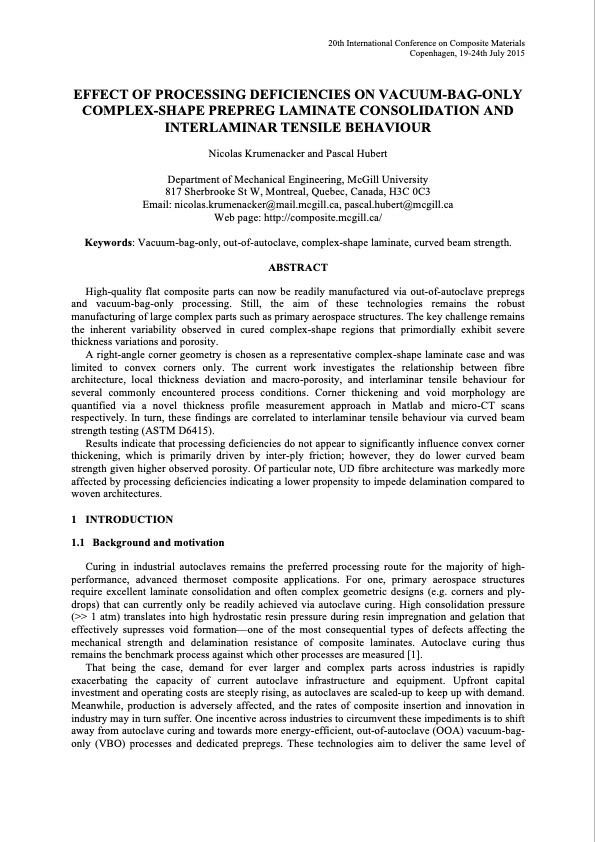
PDF Publication Title:
Text from PDF Page: 001
20th International Conference on Composite Materials Copenhagen, 19-24th July 2015 EFFECT OF PROCESSING DEFICIENCIES ON VACUUM-BAG-ONLY COMPLEX-SHAPE PREPREG LAMINATE CONSOLIDATION AND INTERLAMINAR TENSILE BEHAVIOUR Nicolas Krumenacker and Pascal Hubert Department of Mechanical Engineering, McGill University 817 Sherbrooke St W, Montreal, Quebec, Canada, H3C 0C3 Email: nicolas.krumenacker@mail.mcgill.ca, pascal.hubert@mcgill.ca Web page: http://composite.mcgill.ca/ Keywords: Vacuum-bag-only, out-of-autoclave, complex-shape laminate, curved beam strength. ABSTRACT High-quality flat composite parts can now be readily manufactured via out-of-autoclave prepregs and vacuum-bag-only processing. Still, the aim of these technologies remains the robust manufacturing of large complex parts such as primary aerospace structures. The key challenge remains the inherent variability observed in cured complex-shape regions that primordially exhibit severe thickness variations and porosity. A right-angle corner geometry is chosen as a representative complex-shape laminate case and was limited to convex corners only. The current work investigates the relationship between fibre architecture, local thickness deviation and macro-porosity, and interlaminar tensile behaviour for several commonly encountered process conditions. Corner thickening and void morphology are quantified via a novel thickness profile measurement approach in Matlab and micro-CT scans respectively. In turn, these findings are correlated to interlaminar tensile behaviour via curved beam strength testing (ASTM D6415). Results indicate that processing deficiencies do not appear to significantly influence convex corner thickening, which is primarily driven by inter-ply friction; however, they do lower curved beam strength given higher observed porosity. Of particular note, UD fibre architecture was markedly more affected by processing deficiencies indicating a lower propensity to impede delamination compared to woven architectures. 1 INTRODUCTION 1.1 Background and motivation Curing in industrial autoclaves remains the preferred processing route for the majority of high- performance, advanced thermoset composite applications. For one, primary aerospace structures require excellent laminate consolidation and often complex geometric designs (e.g. corners and ply- drops) that can currently only be readily achieved via autoclave curing. High consolidation pressure (>> 1 atm) translates into high hydrostatic resin pressure during resin impregnation and gelation that effectively supresses void formation—one of the most consequential types of defects affecting the mechanical strength and delamination resistance of composite laminates. Autoclave curing thus remains the benchmark process against which other processes are measured [1]. That being the case, demand for ever larger and complex parts across industries is rapidly exacerbating the capacity of current autoclave infrastructure and equipment. Upfront capital investment and operating costs are steeply rising, as autoclaves are scaled-up to keep up with demand. Meanwhile, production is adversely affected, and the rates of composite insertion and innovation in industry may in turn suffer. One incentive across industries to circumvent these impediments is to shift away from autoclave curing and towards more energy-efficient, out-of-autoclave (OOA) vacuum-bag- only (VBO) processes and dedicated prepregs. These technologies aim to deliver the same level ofPDF Image | VACUUM-BAG-ONLY COMPLEX-SHAPE PREPREG LAMINATE

PDF Search Title:
VACUUM-BAG-ONLY COMPLEX-SHAPE PREPREG LAMINATEOriginal File Name Searched:
paper-2206.pdfDIY PDF Search: Google It | Yahoo | Bing
5,000 BF Shipping Container Lumber Dry Kiln For Quality Lumber The 5,000 BF container kiln consists of one 40 foot high-cube aluminum shipping container... More Info
Shipping Container Lumber Dry Kilns by Global Energy Global Energy designed and developed the container kiln back in 1991. The purpose is to give access to portable sawmill owners, furniture makers, and small business the value added profit of dry kiln lumber and quality hardwoods... More Info
Vacuum Kiln Conversion Kit for Lumber and Wood Dry Kilns Convert your existing conventional dry kiln into a fast drying vacuum kiln. Similar to vacuum bagging in the boat building and aircraft industry, we have come up with a proprietary process which allows you to build a very simple vacuum kiln at a fraction of the price, and without the intensive conventional metal chamber structure... More Info
Vacuum Pump Cart System for Bagging Clamping Wood Drying and more Vacuum Cart with 2HP Pump and Dual Pistons with multiple multiplex vacuum ports and liquid reservoir... More Info
Vacuum Bagging Basics Vacuum bagging is a method of clamping, which has traditionally been used in the composites industry, but can also be used for vacuum drying materials, including wood products... More Info
| CONTACT TEL: 608-238-6001 Email: greg@globalmicroturbine.com | RSS | AMP |